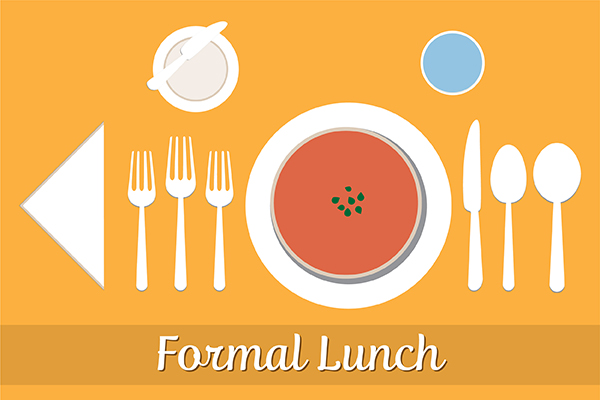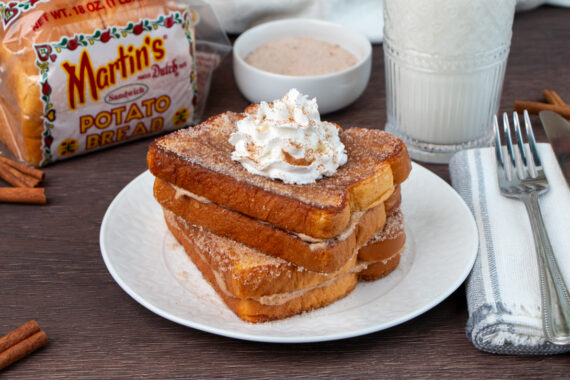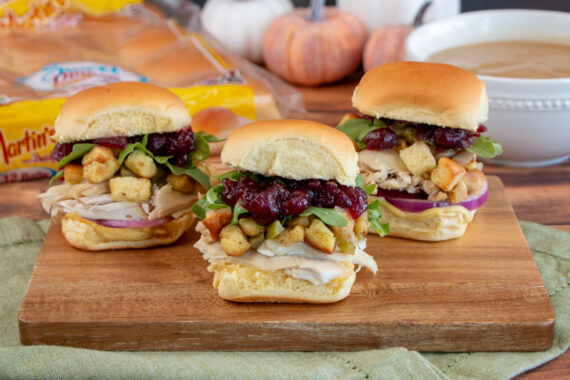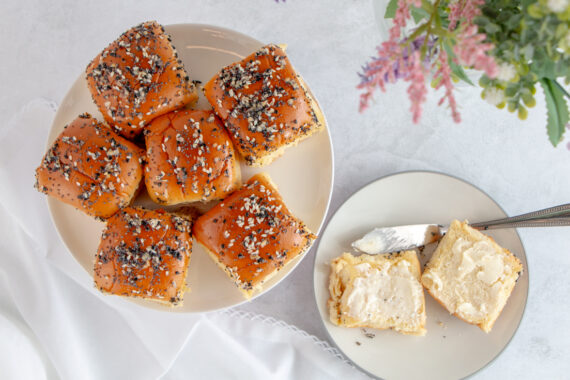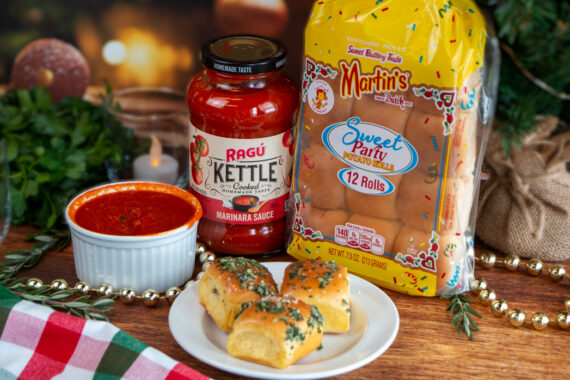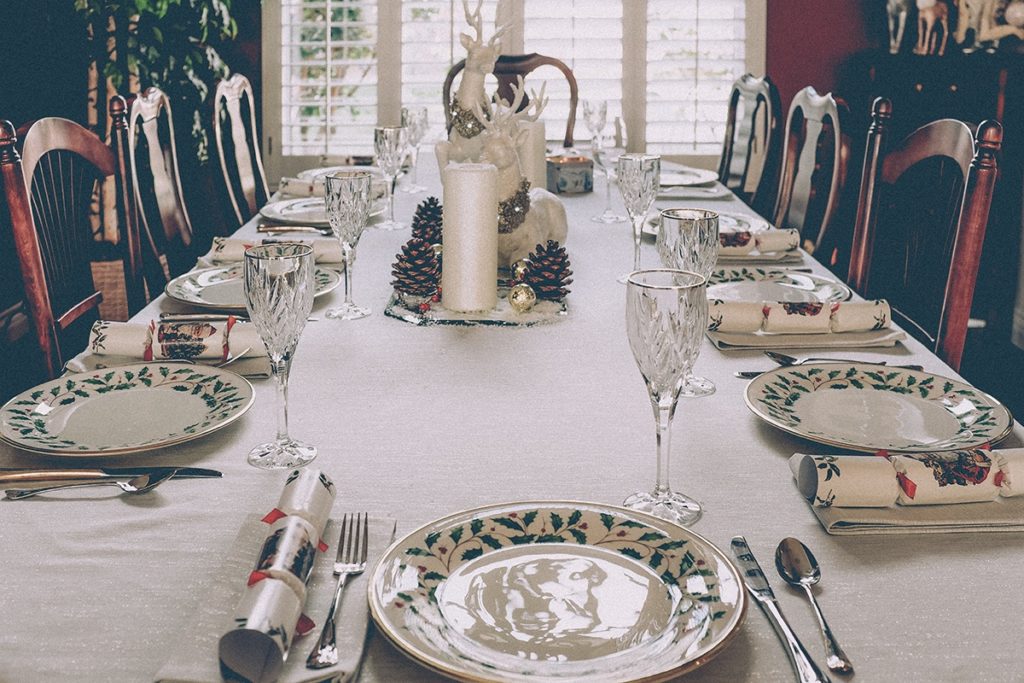
‘Tis the season for delicious meals eaten with family and friends, catching up and celebrating the holidays! Although just being together is perhaps the most important part of these meals, a close second is all the delicious food that you have looked forward to eating all year! So, when you visit someone else’s home to sit down for that long-awaited holiday meal… do you know which fork to use for salad? Do you know the proper way to cut your slice of ham?
When you don’t attend formal meals very often, it’s easy to forget some baseline etiquette guidelines. But, never fear, we’re here to prepare you this holiday season to avoid common dinner table faux pas. Whether you’re hosting a meal or attending one, keep reading for a complete guide on dinner party etiquette.
If You’re the Host(ess): Table Setting
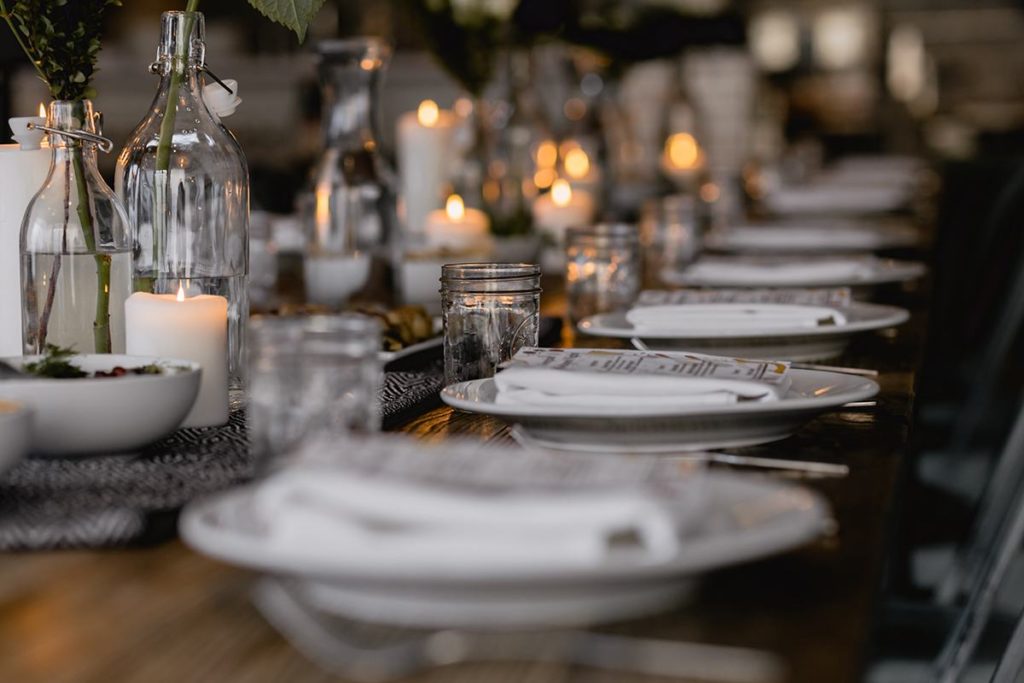
Even if you’re a seasoned host/hostess for casual dinners and parties, you may not often set the table with multiple sets of utensils, like you would for a formal meal. However, especially during the holidays, using a full set of dishes and utensils in the proper table setting is a great way to upgrade your dinner party. So, if you don’t remember where everything is supposed to be, we put together a guide to refresh your memory about proper table settings.
First thing’s first: what type of event or meal are you planning? Table setting for brunch is different than for an informal dinner. So, think about what meal you’ll be serving and how formal you’d like the event to be. Then check out our suggestions below.
NOTE: At some settings, you’ll notice that there are soup spoons, but no soup bowl or a salad fork, but no salad plate, etc. In these instances, the utensils/dishes shown are the ones that should be on the table when the meal begins. If there is a soup spoon, it is understood that you will be serving soup individually. However, if you are not serving soup at all, you may take the soup spoon away as well. The same goes for salad plates/forks, dessert plates/forks, etc.
Breakfast/Brunch
Breakfast table settings typically have less utensils and dishes than lunch and dinner, simply because you won’t need them. You most likely will not be serving salad or soup, so you can ditch the salad fork and plate and soup spoon. And you probably won’t need your dessert utensils either (although breakfast dessert does sound pretty great!).
Breakfast/Brunch Setting: Butter plate and spreader, water glass, juice cup, cup and saucer set, teaspoon, napkin, dinner fork, dinner plate, cereal bowl, dinner knife, table spoon

Lunch
If your family or friends are gathering at lunch time, your table settings will be slightly different than those for dinner. You’ll also want to think about how formal you’d like your lunch to be, as that will affect how you set the table. As you can see in the figure below, lunch settings do not have a cup and saucer, but they do have a salad fork and a soup spoon, depending on how formal your meal would be and what food you are serving.
Informal Lunch Setting: Butter plate and spreader, water glass, napkin, salad fork, dinner fork, lunch plate, dinner knife, teaspoon

Formal Lunch Setting: Butter plate and spreader, water glass, napkin, salad fork, dinner fork, dessert fork, service plate, soup bowl, dinner knife, teaspoon, soup spoon
Dinner
Dinner is generally the most involved of the meals, so in order to have all the proper utensils and dishes for this meal, you may have to plan ahead, particularly if you are having a formal dinner. You may also want to consider placing centerpieces at your tables for dinner, for a more festive and decorative setting.
Informal Dinner Setting: Water glass, salad fork, dinner fork, plate, napkin, dinner knife, teaspoon, soup spoon
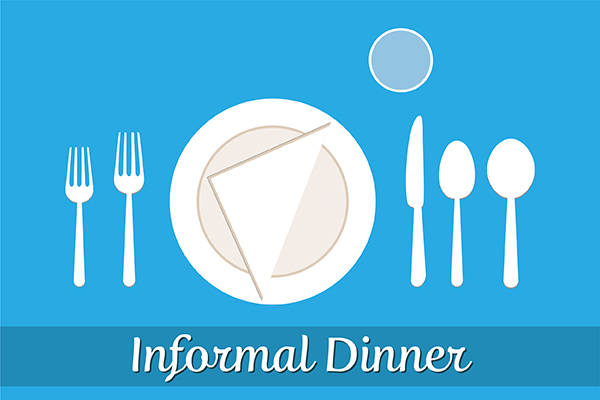
Formal Dinner Setting: Butter plate and spreader, dessert spoon, cake fork, water glass, cup and saucer set, napkin, salad fork, dinner fork, service plate, salad plate, dinner knife, teaspoon, soup spoon
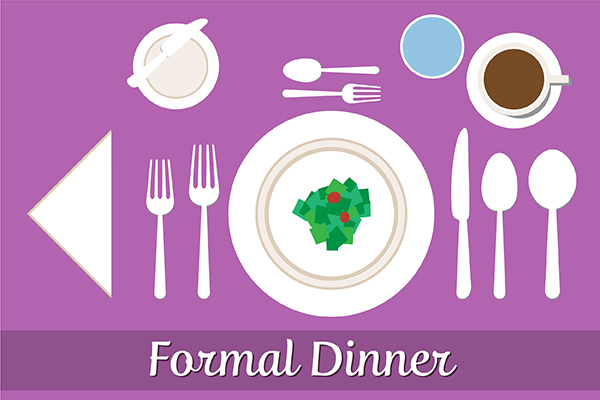
Things to Remember
No matter what meal you are serving, it’s important to remember the “rules of thumb” when it comes to table setting and general hosting etiquette.
- Remember that your guests should generally be using their utensils from the outside in, according to the order of the menu, so arrange your utensils accordingly.
- Knife blades should always be placed with the cutting edge toward the center. Forks are generally to the left-hand side of the plate and knives to the right.
- A good rule of thumb is that there should not be more than three types of one utensil or dish per place setting.
- When you’re looking at which utensils and dishes to place on the table, keep in mind what dishes you will be serving your guests. For example, although a standard breakfast setting includes a juice glass, if you’re not serving juice, you probably won’t need that glass.
- While name tags are not always necessary, you may want to consider using nametags if you’d like to expedite/ease the process of guests deciding where to sit.
- White napkins are typically considered more formal and should be used for dinner and formal lunches. Patterned and printed napkins can be used for breakfast and casual lunches. If you’re feeling particularly ambitious, take a look at some unique ways to fold your napkins here.
- When your guests arrive, offer to take their coats, and try to introduce guests who may not know each other.
- At more casual dinners, it is common for guests to bring their plates to the sink. However, at more formal meals, you as the host are responsible for clearing the plates as you see your guests finish eating.
Searching for recipes to serve at your formal meal? We’ve got plenty of ideas for you at our website: https://potatorolls.com/recipes.
Resources and Additional Tips:
- 25 Dinner Party Dos and Don’ts for a Host or Hostess
- Cheaters’ Guide to Table Etiquette
- Table Setting Guide for Your Next Fancy Dinner
If You’re the Guest: Etiquette
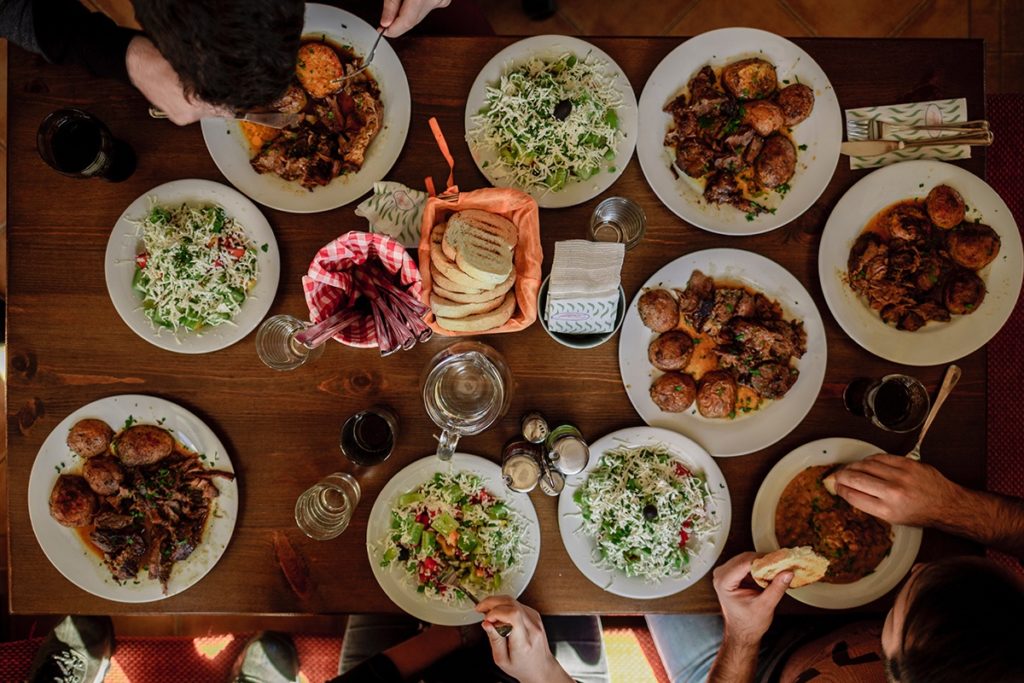
Even if you don’t think the meal you are attending will be very formal, it’s always a good idea to brush up on common courtesies for when you eat a meal at someone else’s home. These are also helpful rules for eating out at a restaurant, for the holidays or otherwise. After all, it’s better to be over prepared than under prepared! Check out our basic etiquette tips below.
At the Table
- Before Eating
- When you sit at the table, place your napkin on your lap and keep it there until you have finished eating. If you have to get up from the table at some point, place the napkin to the left of your plate and remember to place it back on your lap when you return.
- Always wait until all guests are seated and served and a blessing has been said (if applicable) to begin eating. Take note of when your host/hostess begins eating for your cue to start.
- Dishes
- In order to avoid stealing your neighbor’s dishes, try the “thumbs up” trick. Place both your hands in a thumbs up position, and your left had will look like a “b” for bread, and your right hand will look like a “d” for drinks. So, your cups will be to the right of your plate and your bread/butter dish will be to the left.
- When drinking from a stemmed glass, hold it by the stem.
- Utensils
- If you are not familiar with common place settings, it may be a good idea to review them before you arrive (see above). A good rule of thumb is to use utensils from the outside in.
- When cutting your food, switch your fork to your left hand and hold your knife in your right hand. When you are finished cutting, return the fork to your right hand to eat. Only cut one bite of food at a time.
- Similarly, only use your butter knife to butter one bite of bread at a time.
- When eating soup, always return your soup spoon to the service plate below the bowl after eating. Do not leave it in the bowl.
- In the same way, after you’re finished using your butter knife, balance it on the butter dish rather than returning it to the table.
FUN FACT: Archeological research suggests that eating utensils were used as early as 1,000 BC. Dinner knives were not generally used until 16th century France. The modern fork (curved with tines) was not used commonly until about the 18th century.
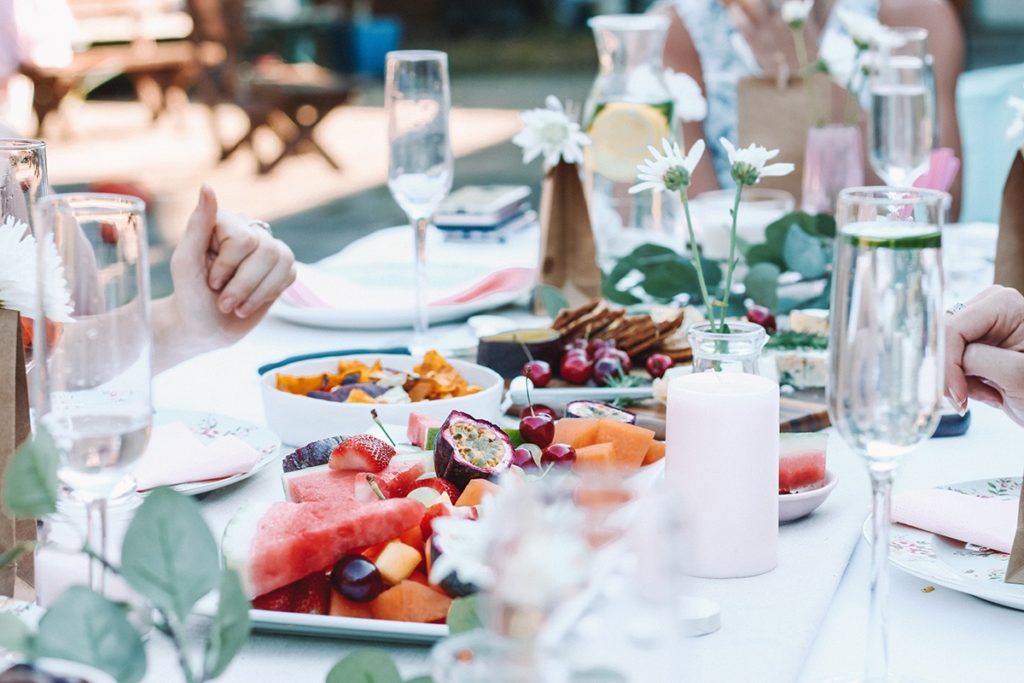
- Food
- If the table is served a whole, uncut loaf or baguette of bread, the host or person closest to the loaf should use a napkin or cloth (which should come with the bread) to cut a few slices. No one should touch a slice of bread with their hands that is not their own.
- If the bread arrives pre-sliced or in rolls, it should be passed around the table to the right. However, if the bread needs to be cut (see above), the one who cuts the bread should offer it to the person on their left and then pass to the right.
- Like the bread, if food is served family style, each person should serve him or herself and then pass the dish to the right (counterclockwise).
- You should always taste your food before you add salt or pepper. If the seasonings are far away from you, ask the person closest to them to pass them to you, as you should do with anything else that you need. Essentially, you should avoid reaching over someone else’s plate for anything you need.
- If someone asks you for the salt and/or pepper, remember that they should always be passed together, regardless if the person asked for both.
- Be mindful of yourself as you are eating. Try not to eat your food too fast, keep your elbows off the table, and, whatever you do, do not talk with your mouth full.
What To Do If…
- You have to sneeze
- Always use your left hand to shield a sneeze or cough, because your right hand is considered your “social hand,” which you use to shake hands.
- You have to use the restroom
- It is okay to excuse yourself from the table, but you do not have to announce your intentions. A simple “excuse me” is sufficient.
- Someone has food on their face or in their teeth
- The best course of action for this is to be direct but discreet. You may try to indicate the problem nonverbally at first, but, if that doesn’t work, a brief but quiet message will do. Once you’ve let them know, try to make conversation with the other guests to allow the person time to fix the problem.
- Someone brings up an uncomfortable topic
- Topics like politics, religion, and any type of gossip are generally not appropriate for the dinner table. So, be polite and pleasant, but try to change the subject if someone starts an uncomfortable conversation. Whatever you do, do not stir up conflict or be confrontational about something you (or others) may disagree with. After all, your host or hostess worked much too hard to have dinner ruined by a heated debate.

Other Etiquette Tips
- It is courteous to RSVP to the event you’re attending as soon as you know if you’re able to attend. Don’t make the host or hostess chase you for an answer.
- Remember to bring a gift for the host and/or hostess of your event to thank them for planning the event. Check out this article for some ideas for each type of event.
- It is important to turn off (or at least silence) your cell phone before you come to the table, and do not bring it out while you are at the table.
- It’s always a good idea to compliment the host/hostess on the food after you’ve finished eating.
- A good rule of thumb at the table and otherwise is to follow the host or hostess’ lead for cues of what to do and how to do it.
- Always thank the host and say goodbye before you leave.
Whether you’re a guest or a host of a formal meal, it all comes down to being courteous and kind. And these rules and tips can be applied beyond just the holidays! Keep them in mind when you attend weddings, showers, or other celebrations.
It’s great to learn all of these classic etiquette customs, but ultimately, you came to (or hosted) this party to celebrate with your family and friends. So, don’t forget to have fun and enjoy the company of those you love while you’re dining and practicing your newfound courtesy tips!

Resources and Additional Tips
- https://www.thespruce.com/table-manners-and-dining-etiquette-1216971
- https://etiquette-ny.com/guide-to-hosting-and-attending-holiday-dinner-parties/
- https://www.thespruce.com/dinner-conversation-etiquette-1216964
- https://www.mentalfloss.com/article/64370/10-etiquette-rules-youre-probably-breaking
- https://www.maggieoldham.com/blog/bread-etiquette
Our latest content, delivered straight to your inbox.
Be the first to hear about our newest recipes, tips, and company updates!

